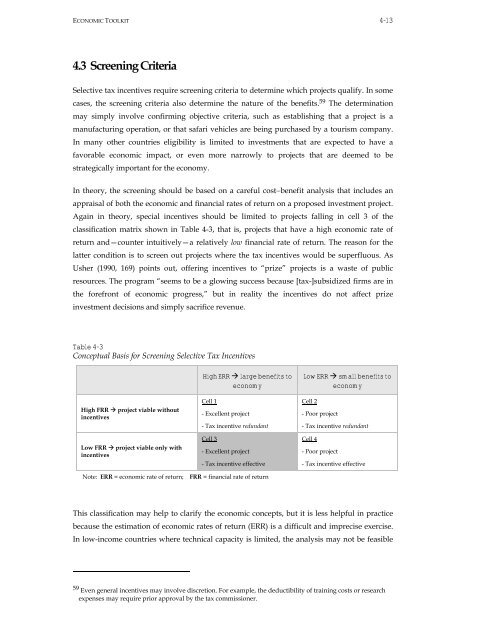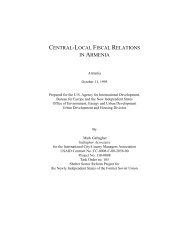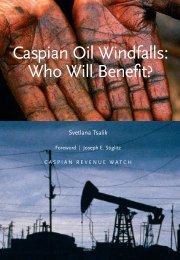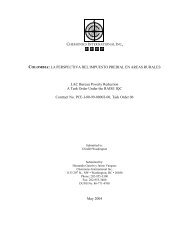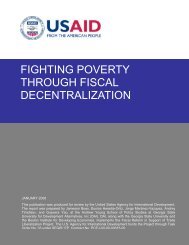Effectiveness and Economic Impact of Tax Incentives in the SADC ...
Effectiveness and Economic Impact of Tax Incentives in the SADC ...
Effectiveness and Economic Impact of Tax Incentives in the SADC ...
Create successful ePaper yourself
Turn your PDF publications into a flip-book with our unique Google optimized e-Paper software.
ECONOMIC TOOLKIT 4-13<br />
4.3 Screen<strong>in</strong>g Criteria<br />
Selective tax <strong>in</strong>centives require screen<strong>in</strong>g criteria to determ<strong>in</strong>e which projects qualify. In some<br />
cases, <strong>the</strong> screen<strong>in</strong>g criteria also determ<strong>in</strong>e <strong>the</strong> nature <strong>of</strong> <strong>the</strong> benefits. 59 The determ<strong>in</strong>ation<br />
may simply <strong>in</strong>volve confirm<strong>in</strong>g objective criteria, such as establish<strong>in</strong>g that a project is a<br />
manufactur<strong>in</strong>g operation, or that safari vehicles are be<strong>in</strong>g purchased by a tourism company.<br />
In many o<strong>the</strong>r countries eligibility is limited to <strong>in</strong>vestments that are expected to have a<br />
favorable economic impact, or even more narrowly to projects that are deemed to be<br />
strategically important for <strong>the</strong> economy.<br />
In <strong>the</strong>ory, <strong>the</strong> screen<strong>in</strong>g should be based on a careful cost−benefit analysis that <strong>in</strong>cludes an<br />
appraisal <strong>of</strong> both <strong>the</strong> economic <strong>and</strong> f<strong>in</strong>ancial rates <strong>of</strong> return on a proposed <strong>in</strong>vestment project.<br />
Aga<strong>in</strong> <strong>in</strong> <strong>the</strong>ory, special <strong>in</strong>centives should be limited to projects fall<strong>in</strong>g <strong>in</strong> cell 3 <strong>of</strong> <strong>the</strong><br />
classification matrix shown <strong>in</strong> Table 4-3, that is, projects that have a high economic rate <strong>of</strong><br />
return <strong>and</strong>—counter <strong>in</strong>tuitively—a relatively low f<strong>in</strong>ancial rate <strong>of</strong> return. The reason for <strong>the</strong><br />
latter condition is to screen out projects where <strong>the</strong> tax <strong>in</strong>centives would be superfluous. As<br />
Usher (1990, 169) po<strong>in</strong>ts out, <strong>of</strong>fer<strong>in</strong>g <strong>in</strong>centives to “prize” projects is a waste <strong>of</strong> public<br />
resources. The program “seems to be a glow<strong>in</strong>g success because [tax-]subsidized firms are <strong>in</strong><br />
<strong>the</strong> forefront <strong>of</strong> economic progress,” but <strong>in</strong> reality <strong>the</strong> <strong>in</strong>centives do not affect prize<br />
<strong>in</strong>vestment decisions <strong>and</strong> simply sacrifice revenue.<br />
Table 4-3<br />
Conceptual Basis for Screen<strong>in</strong>g Selective <strong>Tax</strong> <strong>Incentives</strong><br />
High FRR project viable without<br />
<strong>in</strong>centives<br />
Low FRR project viable only with<br />
<strong>in</strong>centives<br />
High ERR large benefits to<br />
economy<br />
Cell 1<br />
- Excellent project<br />
- <strong>Tax</strong> <strong>in</strong>centive redundant<br />
Cell 3<br />
- Excellent project<br />
- <strong>Tax</strong> <strong>in</strong>centive effective<br />
Note: ERR = economic rate <strong>of</strong> return; FRR = f<strong>in</strong>ancial rate <strong>of</strong> return<br />
Low ERR small benefits to<br />
economy<br />
Cell 2<br />
- Poor project<br />
- <strong>Tax</strong> <strong>in</strong>centive redundant<br />
Cell 4<br />
- Poor project<br />
- <strong>Tax</strong> <strong>in</strong>centive effective<br />
This classification may help to clarify <strong>the</strong> economic concepts, but it is less helpful <strong>in</strong> practice<br />
because <strong>the</strong> estimation <strong>of</strong> economic rates <strong>of</strong> return (ERR) is a difficult <strong>and</strong> imprecise exercise.<br />
In low-<strong>in</strong>come countries where technical capacity is limited, <strong>the</strong> analysis may not be feasible<br />
59 Even general <strong>in</strong>centives may <strong>in</strong>volve discretion. For example, <strong>the</strong> deductibility <strong>of</strong> tra<strong>in</strong><strong>in</strong>g costs or research<br />
expenses may require prior approval by <strong>the</strong> tax commissioner.


